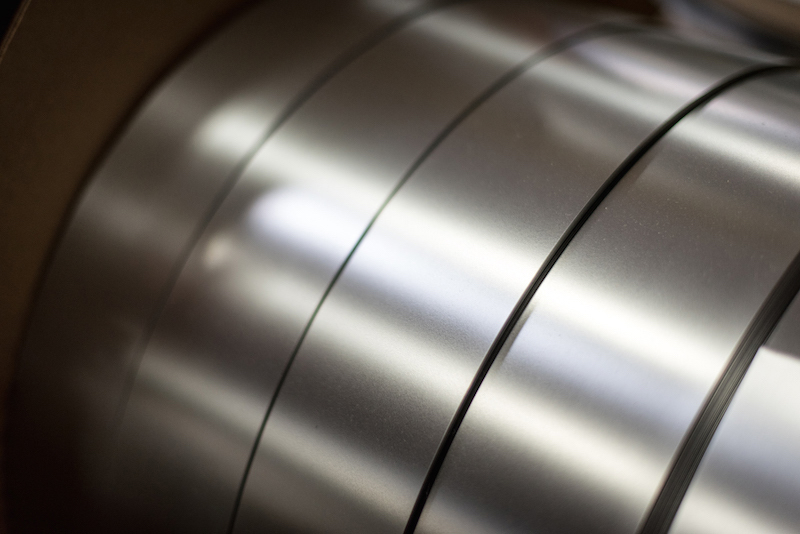Corrosion resistance, high strength, heat resistance, and hygiene properties are among the many well-known attributes of stainless steel. The distinctions between the five main categories of stainless steel come from the differing chemical composition of each.

Image Credit: Ulbrich Stainless Steels & Special Metals.
What is Martensitic Steel?
Martensitic stainless steel is a good choice for a variety of applications because of its durability, strength, and corrosion resistance. The composition and properties of martensitic steel give it advantages over other types of steel in various industrial functions.
Due to its chemical composition, heat and aging treatments can lead to martensitic steel being hardened and strengthened. These treatments make martensitic steel an ideal option when manufacturing mechanical valves and instruments, turbine parts, medical instruments, and other applications and products.
Composition of Martensitic Steel
Chromium usually accounts for 11.5-18% of the composition of martensitic steel, along with 1.2% carbon and nickel. While the lower nickel content makes it less corrosion resistant in comparison with other types of stainless steel, the high percentage of carbon results in the steel having a molecular structure that is particularly robust.
Manganese, nickel, and molybdenum are among the other alloying elements in martensitic steel.
Martensitic Stainless Steel Processing
Rapid Cooling Martensitic Steel
Type 410 stainless steel, 420 stainless steel, and 440A stainless steel are among the most common types of martensitic steels. These martensitic stainless steels react to heat treatment much like high carbon steel alloys. The carbon content defines the maximum quenched hardness of the stainless steel.
Heating the steel to high temperatures which are then followed by a rapid cooling process results in hardening. The high hardenability of martensitic alloys means that this is often called ‘air-hardening’.
The material is usually reheated at low temperatures to stress-relieve the microstructure, or it is reheated to slightly higher temperatures in order to temper (soften) the material to achieve intermediate hardness levels. This is due to the brittle structure of the hardened martensitic material.
Heating the alloy to just below its critical temperature results in process annealing. By contrast, longer cooling after heating the alloy to just above the critical temperature results in full annealing.
Types of Martensitic Steel
The carbon content of martensitic steel means it can in turn be further broken down into two different types.
Low Carbon Martensitic Steel
With its low carbon content of between 0.05% to 0.25%, the low carbon versions of martensitic steel have greater potential for fabrication, offer higher corrosion resistance, and are generally stronger.
High Carbon Martensitic Steel
High carbon martensitic steel usually has a higher carbon content: between 0.61% and 1.50%. An increased carbon content makes the steel stronger as carbon strengthens the molecular structure. It is hard to weld the steel or easily form it into other shapes due to it being more brittle.
Type 410 Stainless Steel
Type 410 stainless steel is a martensitic stainless steel grade that is regarded as a general-purpose martensitic. It can be used in the production of pistons and valves, as well as fasteners, springs, pins, cutlery, hardware, gun clips, micrometer parts, turbine blades, pump rods, coal screens, nuts, and bolts, fittings, ball bearings, impellers, and shafts.
Changes in the hardening and tempering heat treatments will give different levels of hardness.
Type 410 is usually supplied in an annealed form, however, Type 410 can also be supplied with a minimum hardness of RC35 for gauges less than 0.040 ”. A cold rolled version with a minimum tensile strength of 110000 psi is another supply option.
Type 420 Stainless Steel
Covering a fairly wide range of hardness levels in both its hardened and tempered forms, Type 420 stainless steel has a carbon range from 0.15% to 0.45% carbon content.
Heat treating, including cold rolling with a minimum tensile strength of 120000 psi, means Type 420 stainless steel can be provided at various carbon levels to meet specific hardness or mechanical property requirements
Different hardnesses can be obtained via heat treat cycles, which makes Type 420 desirable where tempered products are necessary for specific applications. This steel alloy is hardenable to between RC40-50.
Type 420 stainless steel can be used in a variety of applications including fasteners, cutlery, surgical tools, machine parts, firearms, bushings, and valve trim.
Type 440 Stainless Steel
Though it has limited formability in the annealed condition, Type 440A stainless steel has a greater hardening capability than Type 410 or Type 420.
Being hardenable to over RC50, this grade of stainless steel is extremely suitable for blanking into blade applications. Blades will remain sharper and for longer due to the high hardness of this grade.
Typical uses include:
- Bearings
- Cutlery
- Surgical instruments
In applications where corrosion resistance and high hardness are important, Type 440A is also used.
Other Martensitic Grades
Less common martensitic grades with special chemical composition requirements and/or mechanical properties than the ones listed above are also available on the market. However, the most commonly referenced martensitic steels are Types 410, 420, and 440.
Characteristics of Martensitic Steel
Martensitic steel has multiple properties (besides its strength) that differentiate it from other types of stainless steel. Covering a wide range of applications, grades of martensitic stainless steels are used for combating comparatively mild corrosive conditions or creating maximum stiffness and strength for cold-formed parts.
As they share many of the same characteristics, martensitic steel grades are grouped together when manufacturers are specifying steel alloys.
Weldability
Most forms of martensitic steel do not react favorably to welding as they are typically brittle. When quenched and tempered, it is the brittleness of martensitic steel that increases its applications.
The quenching and tempering process involves heating the metal and then cooling it to set it in place quickly. High carbon martensitic stainless steels are generally not recommended for welded applications, however, Type 410 stainless can be welded with relatively easily.
Magnetism
The crystal-like molecular structure can be magnetic if there is iron present in the martensitic steel alloy. Many types of martensitic steel are magnetic. This can make metals easier to sort but it can make fabrication and welding processes more difficult. Martensitic steels are magnetic in both the hardened and annealed condition.
Formability
A metal's ability to be made into different shapes without breaking or cracking is termed its formability. As its carbon content increases, martensitic steel's formability decreases. While possible, low carbon forms are not ideal for shaping.
High Strength
Martensitic stainless steels are often, though not always, used when high mechanical properties are necessary. Their degree of corrosion resistance limits their application more than other alloys in the stainless steel family.
Superficial rust stains can often appear on their surfaces. They can be used in the annealed condition when only limited corrosion resistance or resistance to elevated temperature scaling is required. Their highest corrosion resistance is attained in the hardened or tempered condition.
Annealed Martensitic Stainless Steel
As they provide the best forming characteristics, the martensitic grades are usually supplied to manufacturers in the annealed condition. Hardening heat treatment generally follows forming operations.
When compared to the 300 series, austenitic stainless steel grades 410 and 420 can also be attained in the cold-worked condition at relatively low tensile strength levels.
How is Martensitic Steel Different from Other Kinds of Stainless Steels?
The various types of stainless steel differ in their chemical structure and components. These factors determine the steel’s behavior and its possible applications.
Austenitic Stainless Steel
This type of stainless steel is highly resistant to corrosion and is one of the most used types of stainless steel as it possesses a high chromium content when compared to other stainless steel types. These steels are also composed of nitrogen, manganese, and nickel.
Austenitic steel is weldable (unlike martensitic steel), formable, and typically non-magnetic. It is not heat treatable – it can only be hardened through cold work.
Ferritic Stainless Steel
Ferritic steel has high chromium and low carbon content. This means ferritic steel is not as strong as martensitic steel (as a result of the low carbon content), but it is very resistant to corrosion and is magnetic.
Most often used in kitchenware, for the construction of industrial machinery, and in the auto industry, ferritic steels are also not heat-treatable. They are processed almost exclusively in the annealed temper.
Precipitations Hardened (PH) Stainless Steel
PH stainless steel is made by adding copper, molybdenum, aluminum, and titanium, either by themselves or in any combination. These metals can be three or four times stronger than austenitic steel and have a relatively low toughness.
Due to its unique blend of strength and good formability, PH steel is typically used in the oil and gas, aerospace, and nuclear industries.
Hardened Martensitic Stainless Steel
Martensitic steel becomes stronger and harder after heat treatment, which is among its main benefits. When heated and rapidly cooled, the atoms become what is known as body-centered tetragonal, a distorted position that makes the steel harder and stronger. Numerous processes can be utilized in order to harden martensitic steel.
Age Hardening
By heating it in order to form precipitates which prevent the movement of defects in the steel's molecular structure, the steel is hardened. The containment of these defects makes the metal harder and stronger. After heating, it is then stored for hours at an elevated temperature until the process, which is often used to increase the strength of the martensitic steel, is complete.
Annealing
Annealing involves heating steel to make the steel's molecular structure more homogeneous and remove stress. This results in softer steel that is easier to manipulate.
Quenching and Tempering
Quenching and tempering is a process that hardens steel by heating, rapidly cooling, and then heating the metal again. The metal is hard but very brittle after the initial heating and cooling, but the second heating is intended to bring the steel back to a temperature at which it is ductile.
Summary
There are multiple types and grades of stainless steel that fit into five main categories. Stainless steel's many distinctive features make it ideal for a wide range of different applications. Martensitic stainless steel is versatile steel that has many practical uses in various industries.
Martensitic stainless steel is very responsive to multiple forms of heat treatment which can increase hardness, strength and corrosion resistance. Martensitic stainless steel's strength and corrosion resistance are ideal for marine, industrial, and medical applications while its versatility can make it the solution to a number of problems.

This information has been sourced, reviewed and adapted from materials provided by Ulbrich Stainless Steels & Special Metals, Inc.
For more information on this source, please visit Ulbrich Stainless Steels & Special Metals, Inc.